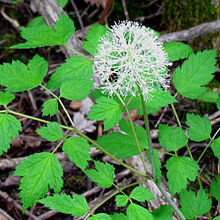- Actaea pachypoda
-
Actaea pachypoda 
flowers and leaves Scientific classification Kingdom: Plantae Division: Magnoliophyta Class: Magnoliopsida Order: Ranunculales Family: Ranunculaceae Genus: Actaea Species: A. pachypoda Binomial name Actaea pachypoda
ElliotActaea pachypoda (Doll's-eyes, White Baneberry) is a flowering plant in the family Ranunculaceae, native to eastern North America.
It is a herbaceous perennial plant growing to 50 cm or more tall (1½ to 2 feet tall and 3 feet wide). It has toothed, bipinnate compound leaves up to 40 cm long and 30 cm broad. The white flowers are produced in spring in a dense raceme about 10 cm long. Its most striking feature is its fruit, a 1 cm diameter white berry, whose size, shape, and black stigma scar give the species its other common name, "doll's eyes". The berries ripen over the summer, turning into a fruit that persists on the plant until frost. Fall foliage color may be yellowish, and is fairly unremarkable.
White baneberry prefers clay to coarse loamy upland soils, and are found in hardwood and mixed-forest stands. In cultivation it requires part to full shade, rich loamy soil, and regular water with good drainage to reproduce its native habitat.
The berries are highly poisonous, and the entire plant is considered poisonous to humans. The berries contain cardiogenic toxins which can have an immediate sedative effect on human cardiac muscle tissue, and are the most poisonous part of the plant. Ingestion of the berries can lead to cardiac arrest and death. The berries are harmless to birds, the plant's primary seed dispersers.
References and external links
- Flora of North America: Actaea pachypoda
- Missouri Plants: Actaea pachypoda
- USDA Plants Profile: Actaea pachypoda
- Bioimages: Actaea pachypoda
- Missouri Botanical Garden Plantfinder Actaea pachypoda
- Karen Legasy, Shayna LaBelle-Beadman and Brenda Chambers. Forest Plants of Northeastern Ontario. Lone Pine Publishing / Queen's Printer for Ontario, 1995.[page needed]
- Edible and Medicinal plants of the West, Gregory L. Tilford, ISBN 0-87842-359-1[page needed]
- Ali, Zulfiqar; Khan, Shabana I.; Pawar, Rahul S.; Ferreira, Daneel; Khan, Ikhlas A. (2007). "9,19-Cyclolanostane Derivatives from the Roots of Actaea pachypoda". Journal of Natural Products 70 (1): 107–10. doi:10.1021/np060152t. PMID 17253859.
- Pellmyr, Olle (1985). "The Pollination Biology of Actaea pachypoda and A. Rubra (Including A. Erythrocarpa) in Northern Michigan and Finland". Bulletin of the Torrey Botanical Club 112 (3): 265–273. doi:10.2307/2996542. JSTOR 2996542.
- Nuntanakorn, Paiboon; Jiang, Bei; Yang, Hui; Cervantes-Cervantes, Miguel; Kronenberg, Fredi; Kennelly, Edward J. (2007). "Analysis of polyphenolic compounds and radical scavenging activity of four American Actaea species". Phytochemical Analysis 18 (3): 219–28. doi:10.1002/pca.975. PMC 2981772. PMID 17500365. http://www.pubmedcentral.nih.gov/articlerender.fcgi?tool=pmcentrez&artid=2981772.
Categories:- Ranunculaceae
- Flora of North America
- Poisonous plants
- Flora of Ohio
- Flora of Alabama
- Flora of Florida
- Native Forbs of Ontario
Wikimedia Foundation. 2010.

